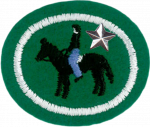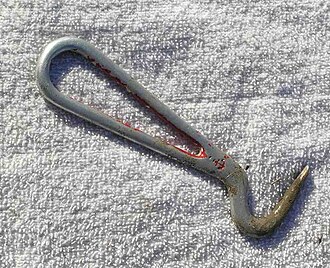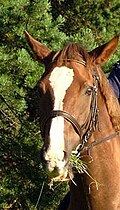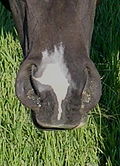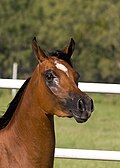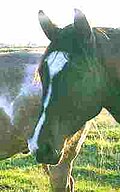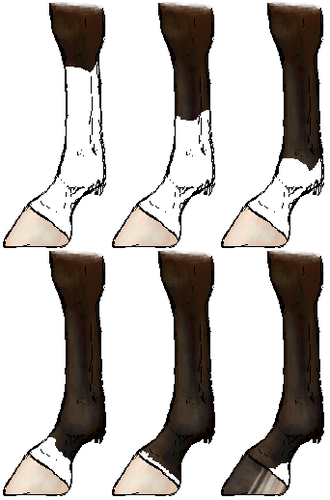AY Honors/Horsemanship - Advanced/Answer Key/es
| Equitación - Avanzado | ||
|---|---|---|
| Asociación General
|
Destreza: 2 Año de introducción: 2000 |
|
Requisitos
(Instructor requerido)
Nota: Todos los requisitos deben ser completados en un ambiente seguro con un caballo gentil.
1
2
3
4
5
6
7
7a
7b
7c
8
9
10
A groom should be especially careful to clean out all crevasses of the hoof, particularly between the frog and the bars, as those areas are most likely to trap rocks or other debris, and also are the most common area to develop thrush. It is best to work the hoof pick from heel to toe, so to avoid accidentally jabbing the horse's leg, the frog of the hoof, or the person using the pick. When picking the feet, the groom stands facing the tail of the horse, then slides his or her hand down the horse's legs. If the horse was not trained to pick up its foot when the groom runs the hand the the fetlock and lifts lightly, most horses will pick up their feet if the tendons behind their cannon bone are squeezed. Some horses, particularly draft breeds, may be trained to pick up their feet when someone pulls on their fetlock hair.
11
12
Horse Colors
Sorrel or Chestnut: A reddish brown horse with reddish, brown or tan mane and tail. Legs are the same color as the body. Their legs may also have white markings. Chestnut runs from very light reddish brown to red or very dark liver color.
Face Markings
- Blaze
- A blaze is a broad strip that runs down the horse's face. It does not extend past the eyes, and it is wider than a stripe.
- Stripe
- A stripe is a narrow blaze.
- Snip
- A snip is a marking between the horse's nostrils
- Star
- A star is a marking between the eyes.
- Race
- A race is a crooked or wavy stripe or blaze.
- Baldface
- Baldface is a wide marking on the face that extends past the eyes. Often, a baldface horse will have blue eyes.
Leg Markings
In order of size:
- 1. Stocking
- Stockings extend above the knee or hock and can bleed onto the flank or belly.
- 2. Fetlock or Sock
- White marking that extends over the fetlock, occasionally called a "boot."
- 3. Pastern
- White marking that extends above the top of the hoof, but stops below the fetlock.
- 4. Coronet
- White just above the hoof, around coronary band, usually no more than 1 inch (2.5cm) above the hoof.
- 5. Partial Pastern
- White marking on only one side of pastern.
- 6. Ermine Spots
- Tiny spots of the coat color that show up on a white marking near the coronet band just above the hoof.
- 7. Black Socks or No White Markings
- Some animals have no white on their legs, although some bay animals will have black socks similar to (or in addition to) white ones.
Additional terms used to describe white leg markings include:
- Irregular: A marking within the broad confines of a given height, but with significantly uneven edges. Indicated by the highest point of the white. Most often used to describe certain types of stockings.
- Partial: An irregular marking that only extends up part of the leg to the height indicated, sometimes with the other side of the leg dark. Usually used to describe socks and other short markings.
- "High White:" White stockings that extend above the knee or hock, sometimes extending past the stifle onto the flank or belly, considered characteristic of the sabino color pattern.
13
14
14a
14b
14c
14d
15
Referencias
- Categoría: Tiene imagen de insignia
- Adventist Youth Honors Answer Book/Honors/es
- Adventist Youth Honors Answer Book/es
- Adventist Youth Honors Answer Book/Skill Level 2/es
- Categoría: Libro de respuestas de especialidades JA/Especialidades introducidas en 2000
- Adventist Youth Honors Answer Book/General Conference/es
- Adventist Youth Honors Answer Book/Recreation/es
- Adventist Youth Honors Answer Book/Recreation/Primary/es
- Adventist Youth Honors Answer Book/Stage 0/es
- Adventist Youth Honors Answer Book/Prerequisite/Horsemanship/es
